Skywatching
§Revised January 2024 jll

www.montananaturalist.org/event/
gallery-show-john-ashley-night-shift-montanas-nocturnal-animals/
|
Course 11 Skywatching is another example of rich and complex material on Nemeta that interfaces closely with other features in the curriculum, primarily the two Vocations 14 Celestics and 15 GNE, but also with the basic practices of 16 Planetary Tantra such as tracking the lunar cycles.So far this course only runs to block 103 and there are some organizational issues. Block 102 The Skies of Memory has only one unit but it contains six audios and a lot of text and illustration. It is presented that way to avoid creating six unit pages for each chapter. Block 103 on the lunar cycles interfaces with other material in PT explaining how to track and read the Dakini frequencies. I must confess that although I know sky-lore and naked-eye astronomy by heart, explaining the basics can be tedious and I find myself stumbling over things I have already said and often trying to say them better when I did good enough in the first place. I will dedicate any future blocks here to the basics of the zodiac, including passages from Quest for the Zodiac (1999) which is currently under revision. I don’t recommend anyone to purchase that book. Starry regards to all. |
ZODIAKOS KYKLOS. Usually translated “belt or circle of animals.” A kyklos is a belt you wear, but it can also mean cycle or circle: you encircle yourself with a belt. Zodiakos derives from the root zoe, “the living, animal life.” Note, by the way, that Zoe appears in Gnostic cosmological texts where she is described as the “flame-born daughter” of Sophia — see below. Somewhere in metahistory.org I commented on the book Dionysos by comparative mythologist and friend of C. G. Jung, Karl Kerenyi, referring to the distinction (correct and essential) he makes between zoe and bios… Actually, it’s cited in NIHI:
“Now when Sabaoth (Mother Star) had taken up the place of refuge in return for her metanoia, Pistis the Sophia gave to the Mother Star her daughter Zoe together with great authority so that she might instruct her about all things that exist in the Ogdoad. (On the Origin of the World, 104.26–31) Zoe is “life force,” but not just as manifested in biological, creaturely life. Zoe is everlasting, self-renewing life. Immersion is the ecstatic life force produced the psychosomatic regeneration of the Mysteries. Mythologist Karl Kerenyi explains that ZOE is the Dionysian factor, the continuum of “indestructible life,” contrasted to BIOS, the limited biological life-process.”
* Ogdoad, the Eighth, is a Mystery term for the celestial realm of starry constellations.
In Course 11 Skywatching you are not merely learning how to read the sky, you are connecting through the “circle of animals” to the indestructible life of the Aeons manifested in cycles of animations. This is a powerful and empowering undertaking.
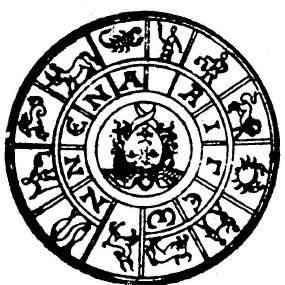
A rare artifact, Roman medallion showing the thirteenth constellation, Ophiuchus, the Snaketamer: At the two o’clock position you see the VIRGIN holding the SCALES, and at the one o’clock position you see the SNAKETAMER. But actually, it is positioned wrongly in the sequence. It should be shown between SCORPION and ARCHER (eleven o’clock position), and the ARCHER points toward the SCORPION not toward the GOATFISH. Despite these errors which indicate a failure of naked-eye observation, the medallion does record the thirteenth constellation which fell into oblivion as the starless astrological signframe came into prominence.
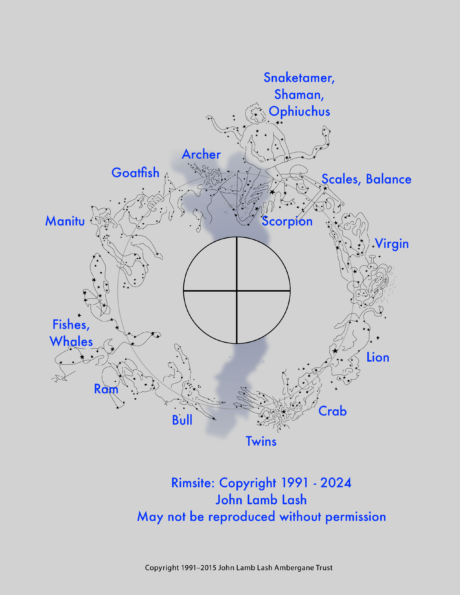
The shaded area is the thin edge of the Milky Way seen from within where the solar system is embedded. Boundaries of the constellation figures are in some cases distinct — Ram<> Fishes — and in other cases hard to determine exactly due to overlap — Fishes<>Manitu, Twins<>Crab, Scorpion<> Snaketamer. The circle running through these figures is the edge of the orbital plane of the earth, the ecliptic. Compare these fine-line Modernist renderings to the iconic 1520 woodcuts of Albrect Durer (color enhancement added):
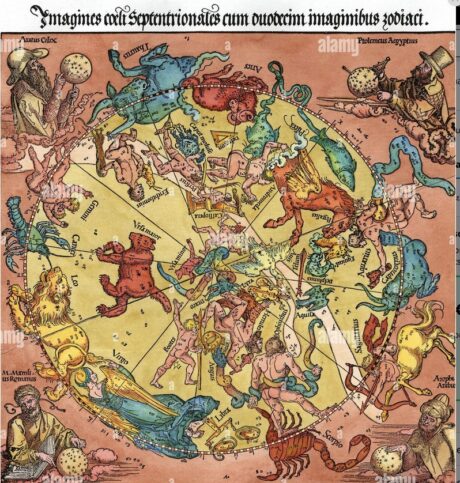
Durer’s figures run clockwise, contrasted to the Rimsite order which runs counter-clockwise.
When I translated zodiakos kyklos I changed the meaning to that above, “circle of animations.” It is most definitely not a circle of animals, obviously not. This is from Quest for the Zodiac, c. 1998 edited for this unit:
Zodiac derives from the Greek, usually translated as ‘circle or belt of animals.’ There must be something wrong with this translation, however. It simply does not fit the phenomenon it names. The Star Zodiac is not a naive liquid-crystal display of animal crackers in the sky. A quick scan of the full panorama in Figure Five reveals that few of the creatures are animals. To be exact, there are no more than three animals here. Count them: Ram, Bull and Lion, plus the (mythological hybrid) silly old Goatfish. How could the entire circle have been named after only three components?
Continuing the inventory, we find four strictly human figures. Two of these belong to the same constellation: the Twins, Castor and Pollux. The others are Ophiuchus, the Snaketamer, a man wrestling with a serpent, and a woman of formidable proportions, known as the Virgin, whose body spans 47 degrees on the Ecliptic. This makes a total of four human figures, counting the Twins as two.
Next there is a superhuman entity, the Watercarrier. The view-lines indicate the shoulders of a figure with his left arm outstretched and his right arm extended downward, holding an urn or amphora. Significantly, the composite stars identified with the head of the figure are dim and obscure. Some ancient catalogues suggest that the head of the Watercarrier may be comprised of stars in the composite of Pegasus, the Winged Horse, situated just above it. This would not be unusual, for there are numerous cases of stars shared by two different constellations. The form of this entity is human-like, while the mythological lore asserts that the Watercarrier is not a human being but a deity, specifically the Lord of the Southern Ocean, Ea or Enki, in Sumerian-Babylonian lore. The tally is now three animals, four human figures and a single superhuman entity, a deity.
Then comes the Archer, a hybrid, half-horse, half-man. This is not a human entity pure and simple, neither is it merely a known form of an animal. The Archer is a fantasy-creature, as is the silly old Goatfish, another hybrid consisting of the fore-body of a goat with the tail of a fish or dolphin. Neither of these is an ‘animal’ of the class found in nature as we know it. So, the inventory continues with two weird fantasy creatures.
Next comes a crustacean, the Crab, an arachnid, the Scorpion, and a couple of Fishes. Some nautical cultures make out the Fishes to be whales, and I have found it helpful to retain this designation. In that case, they would be warm-blooded creatures, classified as mammals and thus close to being ‘animals.’ Crab and Scorpion are, strictly speaking, insects, not quite what we call animals. So the inventory continues: two insects and two fishes.
Finally, the Zodiac includes one mechanical image, a human-made device, the Balance or Scales.
This is, let’s admit, quite an odd ‘belt of animals.’ It is difficult to imagine that the ancient Greeks were so poor in their observation of nature that they made no difference between fish, insects, normal animals and bizarre, hybrid animals. Whatever zodiakos kyklos might originally have meant, it had to be something else. I suggest that ‘cycle of animations’ may be closer to the original sense. The Constellations are mythic images, to borrow a term from Joseph Campbell, a comparative mythologist whose work we will consider in Chapter Fourteen. As such, they are eternal entities whose habitat is human imagination, yet they are supercharged with the power of living creatures. They are animated and animating, for they embody ‘meaning’ as a higher form of vitality.
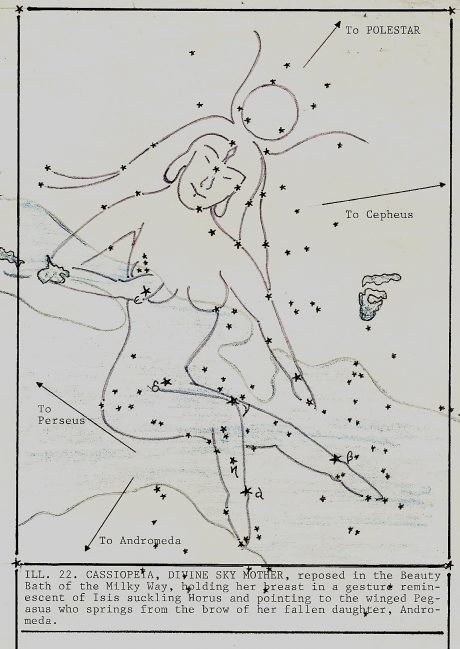
Modernist line rendering of Cassiopeia, mother of Andromeda. This version portrays her bathing in the Milky Way (wavy lines). Compare with the conventional rendering (below) which requires picturing her upside-down, head downward as viewed looking northwards in the northern hemisphere. This constellation is widely recognized by the distinct shape of its signature stars, forming a splayed W. Observers uninformed in skywatching will notice it without knowing that it represents the mythic figure of Cassiopeia. It is situated in the Milky Way between Cepheus and Perseus. It is not an Ecliptic constellation. It is extra-Ecliptic, situated offside the band of the thirteen Zodiacal constellations that present the celestial panorama and main data field for Skywatching.
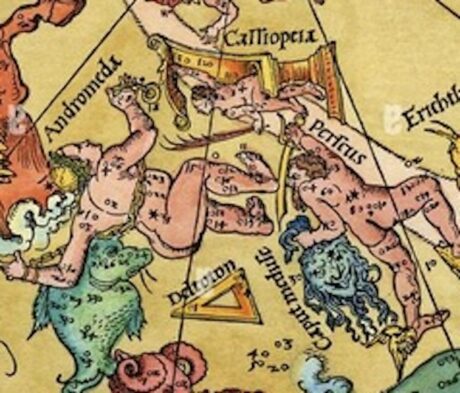
Detail of Durer’s rendering of Cassieopeia sitting on a throne, Andromeda to the left, Perseus to the right. Drer’s style reminds me of the rather grotesque chunky figures in Zap Comix by R. Crumb. The Triangle is a specious constellation which I restore to a mythic image by attaching it within a lunar disk on the head of the Ram. The Egyptian god Amon is often pictured with such a head-disk sometimes combined with a triangular crown.
Skywatching Landing Page Audio:
Correction m27: Chapter Fourteen of Quest for the Zodiac, not Not in His Image.
Additional skills of the shaman which I omitted:
- control of the weather, invocation of elementary forces
- contact with Animal Powers and ability to guide others to that contact
Both of which I have demonstrated. If you don’t mind me saying so.
Requirements
What does Course 11 require that you learn?
First of all, you are required to observe the sky — but hold on, it may be that you do not have the viewing conditions to do so. What then? Does that exclude you from the Course?
Skywatching is an art that combines visualization with observation. Even if you can’t observe, you can still work on the visualization process. You can learn to picture imaginatively what you will eventually, one day, perceive directly with your eyes. So, there are two lines of study in this Course: direct observation, and visual-imaginative orientation, the exercise of picturing. The material of both studies is the same: the thirteen zodiacal constellations on the path of the sun, the Ecliptic Zodiac. Also called the real-sky zodiac, constellational zodiac, stellar zodiac. To be distinguished from the tropical and sidereal zodiac models, as well as the model of Vedic astrology. The operative tool is the Rimsite.
I have explained this problem at length in the interview on futureprimitive.org (see below)
Additionally, the groundwork or entrance conditions for Skywatching require that you learn:
- How to stand in the sky, forming the body mandala
- How to distinguish the 12 sign sectors from the 13 constellations
- How to read an ephemeris
- How to call the constellations by their correct names
- How to coastline: follow the progress of the earth through the sky in the course of a year
- How to use an archontic sky-viewing device without dependence on it
Block 101 The Astral Interface covers all these requirements.
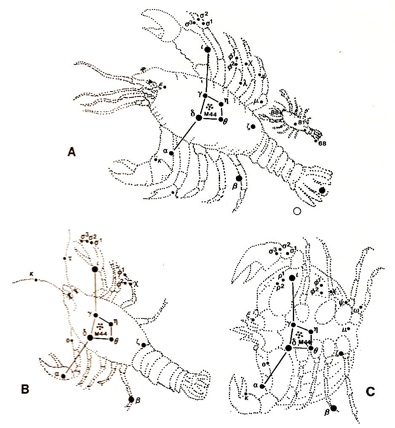
Variations of the CRAB (not Cancer), one of the more difficult of the constellations to picture based on the composite stars and equally difficult to render in graphic form. From Stahl, The New Patterns in the Sky, 1988.
NOTE: Use Constellations of words for research on the lore and picturing of the “cycle of animations.” It contains the full text of the basic research text on sky lore: R. A. Allen, Star Names, 1899.
For an archontic support use the app stellarium.org for orientation but do not become dependent on it exclusively for real-sky observation.
To download this landing page: 11 Skywatching Course Landing Page Audio
Course Curriculum
| § HIGHLIGHTS AND PREVIEWS | |||
| 11 The Perspective of Celestial Timing | 1012 years, 10 months | ||
| 11.101 THE ASTRAL INTERFACE | |||
| 11.101 How to Read an Ephemeris | 1012 years, 10 months | ||
| 11.101 Coastlining | 1012 years, 10 months | ||
| 11.101 Cosmic Centering | 1012 years, 10 months | ||
| Private: 11.101 The Body Mandala | 1012 years, 10 months | ||
| 11.101 In the Phainomorphic Field Skywatching | 1012 years, 10 months | ||
| 11.102 THE SKIES OF MEMORY | |||
| 11.102 Eloquent Enigma | 1012 years, 10 months | ||
| 11.102 Dendera Decoded | 100 years, 4 months | ||
| 11.102 Dendera Synopsis | 91 years, 3 months | ||
| 103 THE LUNAR CYCLE RITUAL | |||
| Private: 11.103 Naked-Eye Mythology | 1012 years, 10 months | ||
| 11.103 The Fibonacci Pattern | 1012 years, 10 months | ||
| 11.103 The Lunation Calendar | 1012 years, 10 months | ||
| 11.103 Lunation Prompts | 1012 years, 10 months | ||
| In development... | |||
| 16.101 Cruising The Lunar Shaktis: Basic Practice in Dakini Instruction | 01:30:00 | ||


